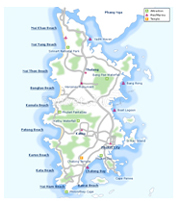Phuket -the Andaman's Pearl
About Phuket
History
Beaches overview
Travel Information
Traveling
Local transportation
Activities
The name Phuket, the Andaman Pearl, is derived
from the Malay word bukit, meaning hill. The island
was previously named Junk Ceylon on European charts,
a corruption of the Malay Tanjung Salang meaning
Cape Salang. Later it became known as Thalang, after
the name of the main town on the island. The island
did not come to be known as Phuket until quite late
in its history when the administrative centre was
moved to a mining town in the centre of the island
called Phuket.

 Geography
Geography
Phuket lies off the west coast of Southern Thailand
in the Andaman Sea, approximately 890km from Bangkok.
It is Thailand's largest island at 550sq km, roughly
the same size as Singapore, and is surrounded by
many smaller islands that add a further 70 sq km
to its total land area. Phuket is separated from
the mainland by the Chong Pak Phra channel at its
northernmost point, where a causeway connects the
island to the mainland.
Phuket is quite hilly. There are a few peaks above
500m, the highest being Mai Tao Sipsong at 529m.
Many of these are covered in lush jungle. The lowlands
consist of rice paddies, plantations of rubber,
pineapple and coconut as well as the only significant
area of rainforest remaining on the island, which
is now protected as Khao Phra Thaeo Park.
The most beautiful beaches are found on the West
coast, separated by rocky coves and headlands. The
east coast comprises limestone shoals with only
a few sandy beaches while spectacular limestone
islands adorn the horizon. Coral gardens full of
exotic marine life dot the emerald waters surrounding
the island, although sadly much of Phuket's coral
has been disappearing due to environmental pressures
and human activities.
 Economy
Economy
Phuket has the second highest per capita income
of any province in Thailand outside of Bangkok.
Tourism has dominated the island's economy for the
past two decades. Each year, over 3 million visitors
arrive to enjoy Phuket's natural splendor and many
amenities. For much of its history, Phuket's economy
was based on tin mining. Since the fall in the demand
for tin in the 1980s and restrictions placed upon
tin dredging to protect the coastal waters, the
industry's importance has greatly declined.
Rubber became an important part of the local economy
at the beginning of the twentieth century when large
areas of rainforest were cut down to make way for
rubber plantations, many of which can still be seen
on the island. Other contributors to the local economy
include: Pearl farms; Agriculture and horticulture
in the form of coconuts, cashews, tapioca, cacao,
rice and pineapple; prawn farming, and the processing
of marine products.


